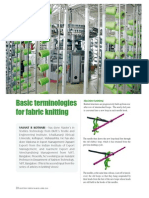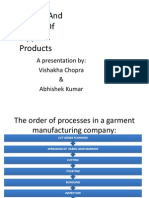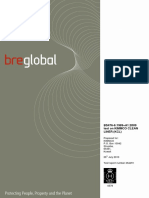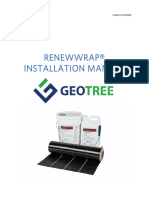Spreading and Cutting Handout
Spreading and Cutting Handout
Uploaded by
Alemu HaileCopyright:
Available Formats
Spreading and Cutting Handout
Spreading and Cutting Handout
Uploaded by
Alemu HaileOriginal Description:
Copyright
Available Formats
Share this document
Did you find this document useful?
Is this content inappropriate?
Copyright:
Available Formats
Spreading and Cutting Handout
Spreading and Cutting Handout
Uploaded by
Alemu HaileCopyright:
Available Formats
Spreading &Cutting Spreading: The process of rolling out layer after layer of cloth, smoothly without wrinkles, in such
a manner that the selvedge on one side of the cloth is straight, and parallel to that edge of the cutting table. Cutting: cutting of fabric in to necessary pattern shapes is the first stage in the garment manufacturing process. The importance of cutting Room The cutting room has a greater effect on excessive manufacturing costs than any other department concerned with the actual production of garments. Internal costs: Those incurred in the cutting room itself. External costs: Those incurred by other departments as a result of the malfunctions of the cutting room. Internal costs Labour: effective utilization Efficiency- The fashion industry is plagued by short lead times Materials- !" to #!" of the cost price of most of the mass produced clothing and largest cost component of a garment.
The factors influencing materials utilization
External costs Co ordination among all the departments Defects- $eadily visible cloth defects must be eliminated during spreading or before issuing the work to the sewing room. Matching- matching of badly aligned components would almost certainly result in distorted garments Accuracy- %uality problems, inaccurate cutting not only causes hold-ups in production but could also mean the costly re-cutting of components. Sewing- &uides for sewing, such as nips, notches, drill holes Shading - accurate shade marking in the cutting room is essential to prevent mi'ing -up. Quality- ('cessive costs can be incurred by the re)ection of finished garments for faults
The !ature of "abric #ac$ages The way in which fabric is rolled or folded when dyeing and finishing is completed is referred to as *put up+. Some methods of put-up are used to protect the fabric others are strictly for the convenience of spreading and handling. ,lat, open and rolled ,olded and $olled Tubular ,olded -ook ,old
"lat% open and rolled& is the most common preparation o The fabric is rolled on a hard cardboard tube .or plastic tube/ where the selvedges are at opposite ends of the tube. o The fabric is usually rolled with the technical face to the inside of the roll.
"olded and Rolled is a put-up that allows the utilization of a single center fold in the length of the goods. 0n this preparation, the fabric selvedges are superimposed one over the other. This preparation is utilized with very wide fabrics that cannot be processed by a manufacturer who does not have wide enough cutting tables.
Tubular "olded goods are prepared by rolling fabrics manufacturers on weft knitting machines.
This preparation results in the technical face of the fabric oriented together. ,or every other layer, the face is not visible from the surface of the spread. 'oo$ "old is the most rela'ed put up. ,abric is laid back and forth in a carton. -ook ,old is used for delicate fabrics to minimize the stress on the fabric. 1 (elvet "rame is used for pile fabrics. 1 tube connects two s%uare frames that contain concentric circles of sharp hooks. The fabric is hung from the hooks where the selvedges are fastened to pairs of hooks .at each edge of the fabric/ starting closest to the center and rotating around the center to the outer edge of the frames. This creates an air space between the concentric layers of fabric. Carded 'olt is a put-up most often seen in men2s suiting and fabric retail. The fabric is folded in half lengthwise, and rolled on a flat board .cardboard/. FA !I" #!E-I$S#E"%I&$ "abric is pre inspected as it arrives in the manufacturing warehouse for two distinct reasons. 3. To confirm that the percentage of damages promised by the mill is not e'ceeded. 4. 5re-marking the damages in the fabric speed up the spreading process, better insuring that the spreader will recognize and remove all the damages in the fabric before they reach the sewing room. #roduction processes in the cutting Room The factor distinguishing the operations of one cutting room from another is the level of technology employed. Cutting production starts with the receipt of inspected raw materials, production orders and graded patterns and finishes when bundles of cut work are issued for sewing.
#lanning )Material *tilization+
Changing market demands and varied production strategies are creating diverse needs for preproduction processes. Small orders, increased fle'ibility, and 6uick $esponse e'pectations are creating the need for fast turns on markers, low-volume spreads, and high-speed low-ply cutters. Material utilization is the process of optimizing the use of materials during product development and production. 1ll preproduction operations-cut order planning, marker making, spreading, and cuttingimpact material utilization. 5reproduction operations are dependent on perfected patterns. Technical designers and production pattern makers develop the patterns for styles accepted into the line, perfect them, and grade them into appropriate sizes. 1ll the patterns in each size of a style are verified, that is, checked very carefully before sending them to cut order planning.
#attern verification Correctness of grade increments Compatibility of grading with style specifications 7ength and alignment of ad)oining seam allowances 8otch placement and alignment with ad)oining pattern pieces. 5lacement of internal markings 5lacement of grain markings
Cut order planning
Cut order planning can be done manually or by computer. 8ew computer technology is much faster, more accurate, and supported with more data on all the variables. Computerized cut order planning allows e'perimentation with alternative cutting plans to develop the most efficient options. Cut order planning is a prere%uisite to tight markers. Responsibilities of Cut order planning& ('amining incoming orders and width and availability of piece goods. 9etermining volume, size ratios, and sectioning procedures for marker making 9etermining whether file markers are available or new ones are needed. 9eveloping specifications for optimum marker making and fabric utilization 9etermining most effective use of spreading and cutting e%uipment. 0ssuing orders for marker making, spreading, and cutting. "actors affecting cut order planning 1s many as fift, different variables, in addition to fabric information, may affect cut order planning. Some of the most common considerations are these: 8umber of sizes in order 8umber of colors in order :a'imum;minimum number sizes allowed in marker. :a'imum spread length of :a'imum ply height 5ercentage of undercut units ,abric cost per yard <sable cloth width overcut or
=idth variation Common lines among pattern pieces Costs of making markers Costs of spreading Costs of cutting Costs of bundling ,abric roll change time
You might also like
- Industrial List of SANWER RoadDocument23 pagesIndustrial List of SANWER RoadNews Journalist50% (8)
- Seams and StitchesDocument21 pagesSeams and StitchesVaanazhaganNo ratings yet
- Advancements in Garment Manufacturing TechnologyDocument19 pagesAdvancements in Garment Manufacturing TechnologyShanmugeshwari Muthiah100% (1)
- Spreading ParametersDocument23 pagesSpreading ParameterssagarNo ratings yet
- Carr and Latham's Technology of Clothing ManufactureFrom EverandCarr and Latham's Technology of Clothing ManufactureDavid J. TylerRating: 4 out of 5 stars4/5 (1)
- Modern Cotton Spinning Machinery, Its Principles and ConstructionFrom EverandModern Cotton Spinning Machinery, Its Principles and ConstructionNo ratings yet
- 6 Rotary Printing Printing Training 1&2Document79 pages6 Rotary Printing Printing Training 1&2Lambo Sun100% (1)
- Textile School Cat 1915 PennDocument174 pagesTextile School Cat 1915 PenntixapoNo ratings yet
- SCAP Session 10 Fabric LossesDocument21 pagesSCAP Session 10 Fabric LossesReena VermaNo ratings yet
- Cutting RoomDocument34 pagesCutting RoomKumar Ankur100% (1)
- Cutting Room Planning: ATDC, BhubaneswarDocument37 pagesCutting Room Planning: ATDC, BhubaneswarBinoy MundaNo ratings yet
- Cutting Room Technology-1,3,4,5Document32 pagesCutting Room Technology-1,3,4,5Utsash SarkerNo ratings yet
- National Institute of Fashion Technology: HyderabadDocument40 pagesNational Institute of Fashion Technology: HyderabadGreeshmaNo ratings yet
- Cutting MarkerDocument66 pagesCutting MarkerTanushree RoyNo ratings yet
- Knitwear Technology (Cutting & Sewing) - APM 7402 - Note Book-1Document25 pagesKnitwear Technology (Cutting & Sewing) - APM 7402 - Note Book-1shahinrezaNo ratings yet
- SpreadingDocument29 pagesSpreadingyuvarajNo ratings yet
- Manual SpreadingDocument4 pagesManual SpreadingarunkadveNo ratings yet
- SpreadingDocument39 pagesSpreadingPratik MinjNo ratings yet
- Different Grading System Used in Apparel IndustryDocument5 pagesDifferent Grading System Used in Apparel Industryzain bajwaNo ratings yet
- We Are The Leaders in Knitted Fabrics of All Kinds in The Sub ContinentDocument6 pagesWe Are The Leaders in Knitted Fabrics of All Kinds in The Sub ContinentMansoor KhanaliNo ratings yet
- Garment CheckerDocument29 pagesGarment Checkerzeeshan_220100% (1)
- Fabric Defect Reading MaterialDocument6 pagesFabric Defect Reading MaterialAnoop Singh100% (1)
- Stitch 140503091259 Phpapp01Document35 pagesStitch 140503091259 Phpapp01Steve ShamNo ratings yet
- Points To Be Considered Before Marker MakingDocument10 pagesPoints To Be Considered Before Marker MakingM.José Copons GalloNo ratings yet
- Marker MakingDocument12 pagesMarker MakingsachipalNo ratings yet
- Fabric Spreading: Presented by - Abhishek Pandey - Ankita Chandel - Mulugeta - Palak SalujaDocument23 pagesFabric Spreading: Presented by - Abhishek Pandey - Ankita Chandel - Mulugeta - Palak SalujaANKITA CHANDELNo ratings yet
- Fabric Spreading - Types of Fabric Spreading - Requirements of Spreading ProcessDocument2 pagesFabric Spreading - Types of Fabric Spreading - Requirements of Spreading ProcessSubrata Mahapatra100% (2)
- Presentation On Fabric CuttingDocument28 pagesPresentation On Fabric CuttingNitta Mallik100% (1)
- Seam PDFDocument15 pagesSeam PDFRakibul Hasan100% (1)
- Practical Manual: Garment Construction Paper Iii - I Year (Voc)Document13 pagesPractical Manual: Garment Construction Paper Iii - I Year (Voc)Srini KalmulaNo ratings yet
- Defects of GarmentsDocument10 pagesDefects of GarmentsSîronamHin MonirNo ratings yet
- Specification Sheet LayoutDocument9 pagesSpecification Sheet LayoutSharvari ShankarNo ratings yet
- Marker Making ModesDocument15 pagesMarker Making ModessamchikkuNo ratings yet
- Preparatory Processes (Cutting Part 1) : Learn Apparel Merchandising Learn Fashion DesigningDocument7 pagesPreparatory Processes (Cutting Part 1) : Learn Apparel Merchandising Learn Fashion DesigningZaman ParvezNo ratings yet
- Defects in GarmentsDocument11 pagesDefects in GarmentsChodathKulangareth BhagavathiTempleNo ratings yet
- Chapter One PDFDocument24 pagesChapter One PDFKibromGereNo ratings yet
- Sewing Needles Used in Sewing MachineDocument6 pagesSewing Needles Used in Sewing MachineKhandaker Sakib Farhad100% (1)
- Department of Fashion TechnologyDocument22 pagesDepartment of Fashion TechnologyAbhishek YadavNo ratings yet
- DefectsDocument31 pagesDefectsKawsar HamidNo ratings yet
- Basic Terminologies For Fabric KnittingDocument3 pagesBasic Terminologies For Fabric KnittingVasant Kothari100% (2)
- Various Technique of Production in Sewing RoomDocument22 pagesVarious Technique of Production in Sewing RoomMansha sharma100% (2)
- L-5 (Marker Making)Document17 pagesL-5 (Marker Making)Kashfmm100% (1)
- 1.fabric Defects and IdentificationDocument16 pages1.fabric Defects and IdentificationRuhi gnextNo ratings yet
- Fabric Care LbellingDocument19 pagesFabric Care LbellingAmar Nath Prasad100% (1)
- Fabric Weight For KnitDocument36 pagesFabric Weight For KnitMohammad Zahirul IslamNo ratings yet
- Marker EfficiencyDocument8 pagesMarker EfficiencyMeeta Arora100% (1)
- Body MeasurementDocument64 pagesBody MeasurementFahima RashidNo ratings yet
- 3b.inspection Procedures in SEWING ROOMDocument26 pages3b.inspection Procedures in SEWING ROOMAlokKumarNo ratings yet
- 4.2BHow To Measure Guide ApparelsDocument37 pages4.2BHow To Measure Guide ApparelsAlokKumar100% (1)
- Spreading and Cutting - Material PDFDocument27 pagesSpreading and Cutting - Material PDFSowmya50% (4)
- VM Section 6 Technical Design Sample & Fit RequirementsDocument46 pagesVM Section 6 Technical Design Sample & Fit RequirementssuditiNo ratings yet
- Statistical Approach To Quality ManagementDocument46 pagesStatistical Approach To Quality Managementmsj fall2021No ratings yet
- Spreading and Cutting of Apparel ProductsDocument42 pagesSpreading and Cutting of Apparel ProductsVishakha Chopra86% (7)
- Stitch-SeamDocument43 pagesStitch-SeamKumera Haileyesus100% (2)
- Presentation of Shrinkage of KnitsDocument21 pagesPresentation of Shrinkage of KnitsRajesh KasettyNo ratings yet
- Neck FinishingDocument7 pagesNeck FinishingShresha DasNo ratings yet
- Textile Manufacturing Process Textile Manufacturing Process Is Done Some Regular ProcessesDocument5 pagesTextile Manufacturing Process Textile Manufacturing Process Is Done Some Regular Processesananthakumar100% (1)
- Fabric Defects & InspectionDocument23 pagesFabric Defects & InspectionYogesh SharmaNo ratings yet
- A&estitchseamdefectsDocument5 pagesA&estitchseamdefectsTee CeeNo ratings yet
- Fabric DefectsDocument5 pagesFabric Defectsalibaqar74100% (5)
- Quality Control for Fashion Start-ups with Chris Walker: Overseas Apparel Production Series, #3From EverandQuality Control for Fashion Start-ups with Chris Walker: Overseas Apparel Production Series, #3Rating: 5 out of 5 stars5/5 (1)
- Buying Eco Fabrics for Fashion Start-ups with Chris Walker: Overseas Apparel Production Series, #2From EverandBuying Eco Fabrics for Fashion Start-ups with Chris Walker: Overseas Apparel Production Series, #2No ratings yet
- Introduction To Cutting Room: Lecturer-1Document8 pagesIntroduction To Cutting Room: Lecturer-1nahidNo ratings yet
- Sewing Room Defects PDFDocument6 pagesSewing Room Defects PDFAlemu HaileNo ratings yet
- US AID in GarmentDocument11 pagesUS AID in GarmentAlemu HaileNo ratings yet
- Course Guide Book Color Theory 2nd FDDocument7 pagesCourse Guide Book Color Theory 2nd FDAlemu HaileNo ratings yet
- Color PsychologyDocument52 pagesColor PsychologyAlemu Haile100% (3)
- Differences Between Statistical Process ControlDocument9 pagesDifferences Between Statistical Process ControlAlemu HaileNo ratings yet
- Skin ColorDocument1 pageSkin ColorAlemu HaileNo ratings yet
- Woven Fabric Defects PracticalDocument2 pagesWoven Fabric Defects PracticalAlemu HaileNo ratings yet
- The Application of TQM in Small and Medium Size EnterprisesdfDocument140 pagesThe Application of TQM in Small and Medium Size EnterprisesdfPratik WaiNo ratings yet
- Hand Stitches PDFDocument8 pagesHand Stitches PDFjadigeetaNo ratings yet
- Key Quality TerminologyDocument6 pagesKey Quality TerminologyAlemu HaileNo ratings yet
- Reg Strati On Slip 4th YearDocument72 pagesReg Strati On Slip 4th YearAlemu Haile0% (1)
- SyllabusDocument47 pagesSyllabusAlemu HaileNo ratings yet
- Knits: Cutting DepartmentDocument4 pagesKnits: Cutting DepartmentjayatiNo ratings yet
- Craft and Textile Heritage PDFDocument16 pagesCraft and Textile Heritage PDFRaj NandiniNo ratings yet
- Stock Screener 31 Aug 2023 1348Document85 pagesStock Screener 31 Aug 2023 13485dj8pd67mpNo ratings yet
- Activity 1Document4 pagesActivity 1Claudette CaballaNo ratings yet
- Synopsis For ManagementDocument4 pagesSynopsis For ManagementGajendra Singh SolankiNo ratings yet
- Hanosimex ProfileDocument18 pagesHanosimex ProfileXuan Loc MaiNo ratings yet
- Protective Technical TextilesDocument14 pagesProtective Technical TextilesNorth valentinoNo ratings yet
- Session 7 - Hosiery Yarn Quality RequirementsDocument68 pagesSession 7 - Hosiery Yarn Quality Requirementsselvakumar100% (2)
- Day 1 NIKE RSL Training EnglishDocument124 pagesDay 1 NIKE RSL Training EnglishNur E Alam NuruNo ratings yet
- 29oct18 - Actual Test 5 Listening - Reading Dressed To DazleDocument3 pages29oct18 - Actual Test 5 Listening - Reading Dressed To DazleYa LiNo ratings yet
- Introduction To PolymersDocument110 pagesIntroduction To Polymersykhamidi3889100% (1)
- Sikawrap®-900 C: Carbon Fibre Fabric For Structural StrengtheningDocument2 pagesSikawrap®-900 C: Carbon Fibre Fabric For Structural StrengtheningRoberto Jimenez PerezNo ratings yet
- Moda en La Primera Guerra MundialDocument15 pagesModa en La Primera Guerra MundialNicole Bayas ManchenoNo ratings yet
- Discover اولى ابتدائي ترم ثاني - ملزمتيDocument248 pagesDiscover اولى ابتدائي ترم ثاني - ملزمتيromaisaanasyoussefNo ratings yet
- Technical Terms of Textile Dyeing: Muhammad Awais ImranDocument19 pagesTechnical Terms of Textile Dyeing: Muhammad Awais ImrantesfayergsNo ratings yet
- Lesson Proper For Week 13Document6 pagesLesson Proper For Week 131206F-Edlyn OrtizNo ratings yet
- SIP-PST Go Dolor Doroteo Rubis Treno FInal PaperDocument21 pagesSIP-PST Go Dolor Doroteo Rubis Treno FInal PaperDrew DoroteoNo ratings yet
- EuroPro Intelli Sew 9136C Sewing Machine Instruction ManualDocument68 pagesEuroPro Intelli Sew 9136C Sewing Machine Instruction ManualiliiexpugnansNo ratings yet
- BS 476 Part 6 - Test Report - KCL-unlockedDocument6 pagesBS 476 Part 6 - Test Report - KCL-unlockedArmağan DemirelNo ratings yet
- Hcssi Scheme of Work For Jss 3Document16 pagesHcssi Scheme of Work For Jss 3bakaretimilehinsamuelNo ratings yet
- Mis 1 PDFDocument24 pagesMis 1 PDFGanapati KattigeNo ratings yet
- Tamils and Technology Unit-1 Question BankDocument11 pagesTamils and Technology Unit-1 Question Bankpdf33843No ratings yet
- GeoTree SolutionsT RenewWrap® FRP Installation ManualDocument30 pagesGeoTree SolutionsT RenewWrap® FRP Installation ManualHéctor Yamill López AmpiéNo ratings yet
- Contemporary Arts Module 1 CompressedDocument143 pagesContemporary Arts Module 1 CompressedHarry John GallardoNo ratings yet
- Pashmina Enhancement & Trade SupportDocument27 pagesPashmina Enhancement & Trade SupportyomeropatternNo ratings yet
- Alchemist Guide ProductionsDocument23 pagesAlchemist Guide ProductionsNovi NovianNo ratings yet
- Firefighter Turnout Coat Configurations: Performance Data For Acquisition DecisionsDocument35 pagesFirefighter Turnout Coat Configurations: Performance Data For Acquisition Decisionsaqsa imranNo ratings yet





































































































